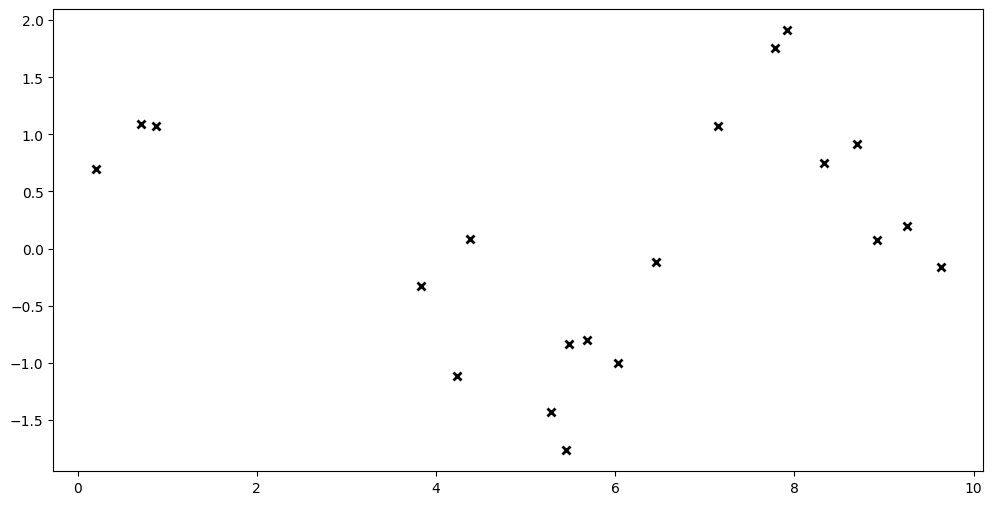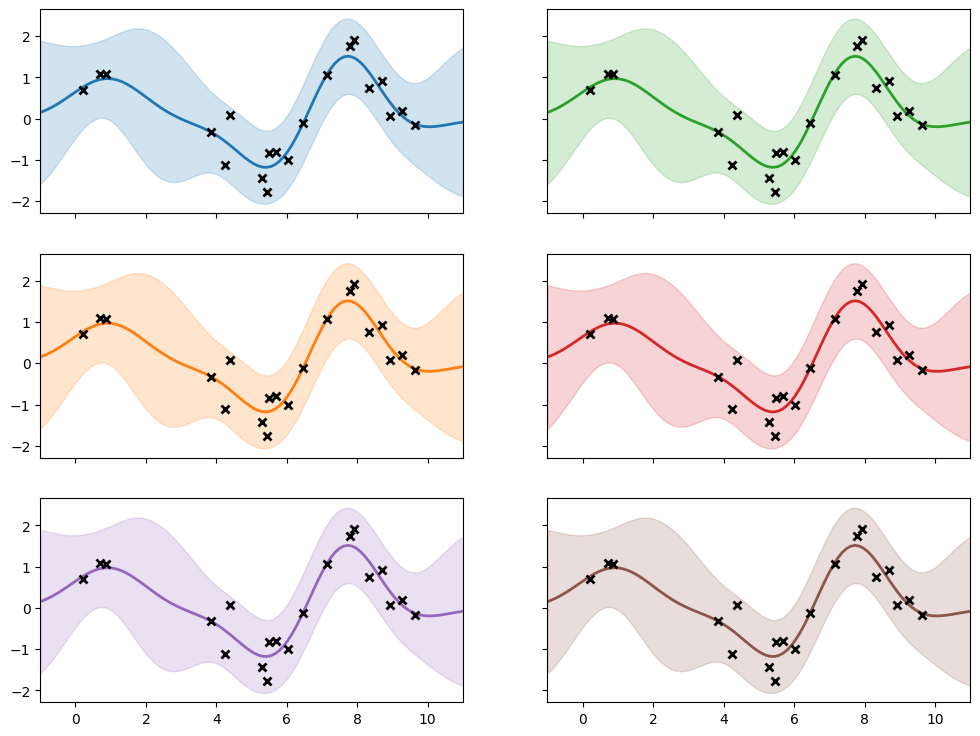Sanity checking when model behaviours should overlap#
Many of the model classes in GPflow have overlapping behaviour in special cases. In this notebook, we fit some approximations to a model with a Gaussian likelihood, and make sure they’re all the same.
The models are: - GPR: Full Gaussian process regression.
VGP: A Gaussian approximation with Variational Bayes. Approximating a Gaussian posterior with a Gaussian should be exact.SVGP: a sparse GP, with a Gaussian approximation. The inducing points are set to be at the data points, so again, should be exact.SVGP(with whitened representation): As above, but with a rotation applied to whiten the representation of the process.SGPR: A sparse GP with a collapsed posterior (Titsias 2009). Again, the inducing points are fixed to the data points.GPRFITC: The FITC approximation. Again, the inducing points are fixed to the data points.
In all cases the parameters are estimated by the method of maximum likelihood (or approximate maximum likelihood, as appropriate). The parameter estimates should all be the same.
[1]:
import matplotlib.pyplot as plt
import numpy as np
import tensorflow as tf
import gpflow
from gpflow import set_trainable
from gpflow.ci_utils import reduce_in_tests
from gpflow.config import default_float
from gpflow.models import (
maximum_log_likelihood_objective,
training_loss_closure,
)
%matplotlib inline
plt.rcParams["figure.figsize"] = (12, 6)
2024-02-07 11:46:46.573363: I external/local_tsl/tsl/cuda/cudart_stub.cc:31] Could not find cuda drivers on your machine, GPU will not be used.
2024-02-07 11:46:46.622601: E external/local_xla/xla/stream_executor/cuda/cuda_dnn.cc:9261] Unable to register cuDNN factory: Attempting to register factory for plugin cuDNN when one has already been registered
2024-02-07 11:46:46.622646: E external/local_xla/xla/stream_executor/cuda/cuda_fft.cc:607] Unable to register cuFFT factory: Attempting to register factory for plugin cuFFT when one has already been registered
2024-02-07 11:46:46.624337: E external/local_xla/xla/stream_executor/cuda/cuda_blas.cc:1515] Unable to register cuBLAS factory: Attempting to register factory for plugin cuBLAS when one has already been registered
2024-02-07 11:46:46.632857: I external/local_tsl/tsl/cuda/cudart_stub.cc:31] Could not find cuda drivers on your machine, GPU will not be used.
2024-02-07 11:46:46.633676: I tensorflow/core/platform/cpu_feature_guard.cc:182] This TensorFlow binary is optimized to use available CPU instructions in performance-critical operations.
To enable the following instructions: AVX2 AVX512F FMA, in other operations, rebuild TensorFlow with the appropriate compiler flags.
2024-02-07 11:46:47.832396: W tensorflow/compiler/tf2tensorrt/utils/py_utils.cc:38] TF-TRT Warning: Could not find TensorRT
[2]:
np.random.seed(0)
X = np.random.rand(20, 1) * 10
Y = np.sin(X) + 0.9 * np.cos(X * 1.6) + np.random.randn(*X.shape) * 0.4
Xtest = np.random.rand(10, 1) * 10
plt.plot(X, Y, "kx", mew=2)

[3]:
data = (
tf.convert_to_tensor(X, dtype=default_float()),
tf.convert_to_tensor(Y, dtype=default_float()),
)
inducing_variable = tf.convert_to_tensor(X, dtype=default_float())
m1 = gpflow.models.GPR(data, kernel=gpflow.kernels.SquaredExponential())
m2 = gpflow.models.VGP(
data,
kernel=gpflow.kernels.SquaredExponential(),
likelihood=gpflow.likelihoods.Gaussian(),
)
m3 = gpflow.models.SVGP(
gpflow.kernels.SquaredExponential(),
gpflow.likelihoods.Gaussian(),
inducing_variable,
q_diag=False,
)
set_trainable(m3.inducing_variable, False)
m4 = gpflow.models.SVGP(
gpflow.kernels.SquaredExponential(),
gpflow.likelihoods.Gaussian(),
inducing_variable,
q_diag=False,
whiten=True,
)
set_trainable(m4.inducing_variable, False)
m5 = gpflow.models.SGPR(
data,
kernel=gpflow.kernels.SquaredExponential(),
inducing_variable=inducing_variable,
)
set_trainable(m5.inducing_variable, False)
m6 = gpflow.models.GPRFITC(
data,
kernel=gpflow.kernels.SquaredExponential(),
inducing_variable=inducing_variable,
)
set_trainable(m6.inducing_variable, False)
models = [m1, m2, m3, m4, m5, m6]
Now, we optimize the models. For GPR, SVGP, and GPRFITC, this simply optimizes the hyperparameters (since the inducing points are fixed). For the variational models, this jointly maximises the lower bound to the marginal likelihood (Evidence Lower Bound, ELBO) with respect to the variational parameters and the kernel and likelihood hyperparameters.
[4]:
for m in models:
opt = gpflow.optimizers.Scipy()
loss_closure = training_loss_closure(m, data)
opt.minimize(
loss_closure,
variables=m.trainable_variables,
options=dict(maxiter=reduce_in_tests(1000)),
compile=True,
)
If everything worked as planned, the models should have the same:
prediction functions
log (marginal) likelihood
kernel parameters
For the variational models, where we use a ELBO in place of the likelihood, the ELBO should be tight to the likelihood in the cases studied here.
[5]:
def plot(m, color, ax):
xx = np.linspace(-1, 11, 100)[:, None]
mu, var = m.predict_y(xx)
ax.plot(xx, mu, color, lw=2)
ax.fill_between(
xx[:, 0],
mu[:, 0] - 2 * np.sqrt(var[:, 0]),
mu[:, 0] + 2 * np.sqrt(var[:, 0]),
color=color,
alpha=0.2,
)
ax.plot(X, Y, "kx", mew=2)
ax.set_xlim(-1, 11)
f, ax = plt.subplots(3, 2, sharex=True, sharey=True, figsize=(12, 9))
plot(m1, "C0", ax[0, 0])
plot(m2, "C1", ax[1, 0])
plot(m3, "C2", ax[0, 1])
plot(m4, "C3", ax[1, 1])
plot(m5, "C4", ax[2, 0])
plot(m6, "C5", ax[2, 1])

Here are the kernels and likelihoods, which show the fitted kernel parameters and noise variance:
[6]:
for m in models:
print(m.__class__.__name__)
print(f" kernel lengthscale = {m.kernel.lengthscales.numpy():.5g}")
print(f" kernel variance = {m.kernel.variance.numpy():.5}")
print(f" likelihood variance = {m.likelihood.variance.numpy():.5}")
GPR
kernel lengthscale = 1.0774
kernel variance = 0.82561
likelihood variance = 0.16002
VGP
kernel lengthscale = 1.0773
kernel variance = 0.82546
likelihood variance = 0.16002
SVGP
kernel lengthscale = 1.0774
kernel variance = 0.82549
likelihood variance = 0.16003
SVGP
kernel lengthscale = 1.0774
kernel variance = 0.82549
likelihood variance = 0.16003
SGPR
kernel lengthscale = 1.0774
kernel variance = 0.82561
likelihood variance = 0.16002
GPRFITC
kernel lengthscale = 1.0774
kernel variance = 0.82561
likelihood variance = 0.16002
Here are the likelihoods (or ELBOs):
[7]:
for m in models:
print(
f"{m.__class__.__name__:30} {maximum_log_likelihood_objective(m, data)}"
)
GPR -18.83436136005662
VGP -18.834361541115168
SVGP -18.834400091468947
SVGP -18.834400091468947
SGPR -18.834399989062064
GPRFITC -18.834354780715636